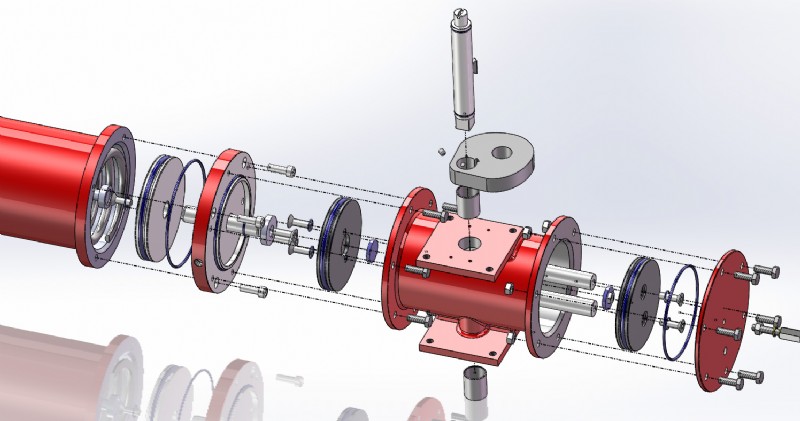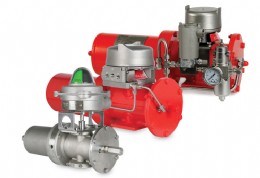Trends in Pneumatic Spring Return Valve Actuator Selection


Actuator sizing depends on the various valve torque values, minimum supply pressure and actuator-valve safety margins / factors considered to cover the service life of a valve.
When sizing pneumatic actuators for fail-safe valves, torque safety factors can vary depending on project specifications. Valve torques can also vary from break to open and running end to close positions.
End users normally determine the valve safety factor during the design stage and valve manufacturers therefore, do not need to add extra contingencies. Generally, these safety margins are determined with the goal that the valve should operate smoothly throughout its service life, irrespective of the process condition.
Increasingly, the safety factor applied when coupled with the specified minimum sizing and normal supply pressure range for actuation selection, can result in selected actuator torques exceeding the maximum acceptable stem torque (MAST) specified by the valve manufacturer.
For example, in the oil and gas industry, three different application categories for safety margin are commonly designed for the on/off actuator valves:
1. General Duty like Process On/Off valves the valve will have an actuator with a torque output of at least 1.3 times the operational torque requirement of the valve (+ 130% or x 1.3 safety)
2. Process Duty like Shut Down and Blow Down valves will have an actuator with a torque output of at least 1.5 times the operational torque requirement of the valve (+150% or x 1.5 times)
3. Safety Duty like Emergency Shut Down valves the valve will have an actuator with a torque output of at least 2 times the operational torque requirement of the valve (200% or x 2 safety). Although, some operators go up to +250% or x 2.5 safety or higher!
Many valve producers are able to offer higher tensile strength stem materials for large ball and plug valves, which are used in many shut down applications in order to raise the MAST values.
However, this is not true for smaller ball valves (up to 50mm bore) when it can be challenging to source the stem material to take care of 200% or 250% safety factor requirements because of the limitations in the physical size or valve design.
In many applications where space limitation and structural load are on the of the most significant concerns i.e. offshore drilling platforms, FPSOs etc. many customers will use triple offset and / or high performance butterfly valves instead of ball and plug valves. However, in larger bore sizes, the smaller dimensions of these valves when compared with ball and plug valves results in stem sizes that are generally smaller and weaker.
The most commonly used actuators for automating on/off 90° valves utilise either the well proven rack and pinion or scotch yoke mechanisms.
The rack and pinion type gives constant torque output throughout the stroke and is used for smaller sized valves.
The scotch yoke type is effective for larger valves where a higher torque requirement is needed at the beginning of the stroke.
In the energy related industries, the scotch-yoke system is often preferred. However, due to the inherent design and torque curve characteristics of the design, it is not always the best choice when using spring return versions for fail safe applications where there are valve MAST issues to consider. For the spring direction of any pneumatic actuator, the spring size has to be large enough to ensure the end of the spring torque closes the valve with the specified safety margin built in.
With a conventional scotch-yoke actuator, the air side is not independent of the spring side. This means that during the air stroke, the actuator air cylinder not only has to be a large enough diameter to produce sufficient torque with the specified safety margin to break the valve from its seat, but it also has to overcome the spring force which increases as it moves from 0° (spring extended) position to 90° (spring compressed) position!
The result is a dimensionally large scotch-yoke actuator, producing extremely high break torques resulting in the maximum torque output from the actuator reaching or even exceeding the valve MAST value.
To overcome this problem when valve MAST issues occur, many customers are adopting an actuator design which utilises a unique cam mechanism working in conjunction with a self contained spring module.
This design offers two primary benefits;
1. The mathematically derived cam profile maintains a constant Moment Arm throughout the actuator stroke. This ensures a constant torque output is achieved for the full 90° travel of the actuator. 2. The self contained spring module operates independently from the cam mechanism during the air stroke. This is achieved using a secondary air piston sized solely to compress the spring. Thus, unlike many other spring return actuators where the torque is significantly reduced compared to its double acting version, the cam actuator has the same constant torque output for both double acting and spring return versions.
When using scotch-yoke actuators, it is common practice to include a pressure regulator in conjunction with a relief valve into the pneumatic circuit control system when faced with valve MAST issues. However, it is the inherent design of the cam principle actuator itself which enables plant operators to install automated valves that meet their design considerations reducing the risk of valve stem damage.
An added benefit exists in that the cam actuator is physically smaller than the comparable spring return scotch yoke actuator, allowing for space savings to be achieved across the plant and in turn less infrastructure and cost.
Tel: 08700 340 002
Email: sales@imtex-controls.com
Web: www.imtex-controls.com

| Telephone: | 08700 340002 |
| Email: | sales@imtex-controls.com |
| Website: | www.imtex-controls.com |
| More information on the IMTEX CONTROLS LTD BVAA Member Directory Page |
Search related valve / actuator articles: IMTEX CONTROLS LTDIssue 44Butterfly ValvesBall ValvesValve AutomationSafety and StandardsMaster ClassPneumatic ActuatorsPlug Valves











